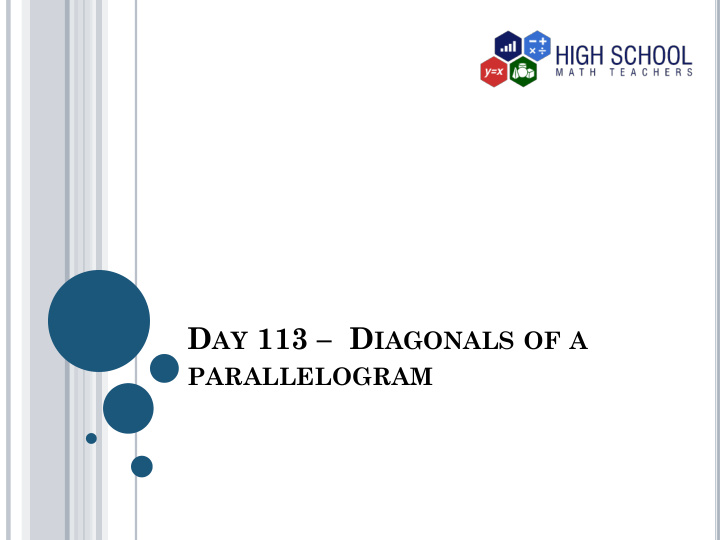



D AY 113 – D IAGONALS OF A PARALLELOGRAM
I NTRODUCTION We are not yet done with all the properties of a parallelogram. In the previous lessons, our focus was first on the boundaries of a parallelogram. We then came to the inside, to discuss the properties of what is enclosed within the sides; the angles. We would now like to look at the diagonals and their intersection. In this lessons, we are going to prove that diagonals of a parallelogram are not equal. Show that at their intersection, opposite angles are equal and adjacent angles are the supplementary angle
V OCABULARY Parallelogram Is a four sided figure with opposite sides parallel and equal and no interior angle equal to 90°. Adjacent angles Angles that share a ray and a vertex. Supplementary angle Angles that add up to 180°
Parallelogram This is a four sided figure where opposite sides are equal and parallel. The opposite angles are equal and adjacent angles add up to 180° We would like to prove that to prove that diagonals of a parallelogram are not equal. We will also show that at their intersection, opposite angles are equal and adjacent angles are supplementary angle Consider the parallelogram PQRS S R T P Q
We extract two triangles having different diagonals R S P Q P Q Using properties of a parallelogram opposite sides are parallel and equal; and adjacent angles are supplementary, we have PQ common to all triangles, 𝑄𝑇 = 𝑅𝑆. The included angles are ∠𝑇𝑄𝑅 𝑏𝑜𝑒 ∠𝑄𝑅𝑆 . But ∠𝑇𝑄𝑅 ≠ ∠𝑄𝑅𝑆 since they are supplementary angles and not right angles by properties of parallelograms. Hence SAS congruent postulate is not satisfied.
Therefore, at least one pair of corresponding sides are not equal. Since other pairs are congruent, third pair, SQ and PR. Thus, 𝑇𝑅 ≠ 𝑄𝑆, implying that the diagonals are not equal. Intersections of the diagonals We now wish to prove that that at their intersection, opposite angles are equal and adjacent angles are supplementary angle. We will employ an earlier proved result that diagonals of a parallelogram intersects each other.
Consider the parallelogram below S R T P Q Using properties of parallelogram, we have 𝑆𝑅 = 𝑄𝑇 . Since diagonals intersects each other, 𝑇𝑈 = 𝑅𝑈 and 𝑄𝑈 = 𝑆𝑈 . Thus, corresponding angles are equal, the SSS congruence postulate applies showing that PST and RQT. Thus corresponding angles are equal. Hence, ∠𝑇𝑈𝑄 = ∠𝑅𝑈𝑆.
Using properties of parallelogram, we have 𝑄𝑅 = 𝑆𝑇 . Since diagonals intersects each other, 𝑇𝑈 = 𝑅𝑈 and 𝑄𝑈 = 𝑆𝑈 . Thus, corresponding angles are equal, the SSS congruence postulate applies showing that PQT and RST. Thus corresponding angles are equal. Hence, ∠𝑆𝑈𝑇 = ∠𝑅𝑈𝑄. Since the diagonals are straight lines and intersects each others, the adjacent angles are supplementary since they are angles on a straight line.
Example Given that 𝑈𝐻𝑋𝑆 is a parallelogram, find the size of angle GYW and angle WYR if 𝑏𝑜𝑚𝑓 𝑈𝑍𝐻 = 98° . R W Y 98° T G Solution ∠𝑈𝑍𝐻 + ∠𝐻𝑍𝑋 = 180° ; ∠𝑈𝑍𝐻 = 98° 98 + ∠𝐻𝑍𝑋 = 180° ; ∠𝐻𝑍𝑋 = 82° . ∠𝑋𝑍𝑆 + ∠𝐻𝑍𝑋 = 180° ; since ∠𝐻𝑍𝑋 = 82° ∠𝑋𝑍𝑆 + 82° = 180° ; hence ∠𝑋𝑍𝑆 = 98°
HOMEWORK Identify the statement as true or false about a parallelogram. (i). Diagonals bisects each other (ii). Diagonals are equal
A NSWERS TO HOMEWORK (i). True (ii). False
THE END
Recommend
More recommend